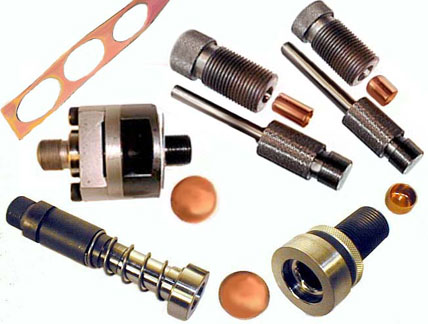|
Corbin JMK-1-S Bullet Jacket Making Kit
The Corbin JMK-1-S Jacket Making Kit, for use with the Corbin S-Press, makes precision bullet jackets in .452 caliber, which can then be redrawn to other calibers and trimmed to length by adding a JRD-2-S commercial grade jacket draw die and an adjustable trim die (ET-2-S) for each smaller caliber desired. The die set uses 1-inch wide by .030-thick copper strip, deep drawing grade with finished edges. Corbin furnishes copper in 5-lb bundles or 50-pound copper coils.
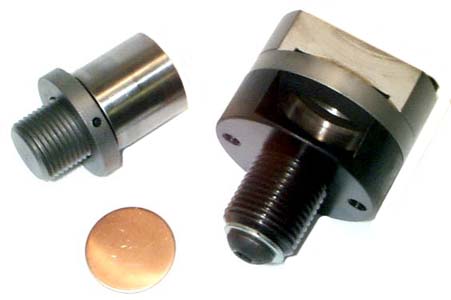 The strip is first passed through a slot in the Disk Cutter Die, where a punch mounted in the standard floating punch holder, in the press head, cuts a disk from the inch-wide strip and drops the disk out an angled exit port in the lower die section. The die itself screws into the press ram. The press is used in the short stroke or swaging mode (2-inch ram travel) for maximum power.
The strip is first passed through a slot in the Disk Cutter Die, where a punch mounted in the standard floating punch holder, in the press head, cuts a disk from the inch-wide strip and drops the disk out an angled exit port in the lower die section. The die itself screws into the press ram. The press is used in the short stroke or swaging mode (2-inch ram travel) for maximum power.
The strip is pulled through the slot, the handle moved up and down in short strokes, just enough
to cut the metal, and the strip advanced to the next position by observing the relation of the last hole in the strip compared to the edge of the die, leaving enough metal between holes for a good disk to be cut on the next stroke.
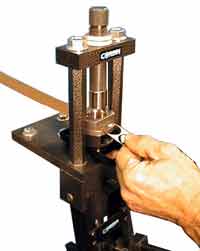
After the disks are cut, the cupping die and punch assembly are put into the press. The cupping die itself goes into the ram from the bottom side, which is the opposite of most dies. The spring-supported guide and punch screw into the ram. A lubricated disk is placed in the top of the guide, which in turn is held in position on top of the punch.
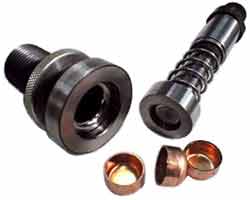
The press is operated, raising the ram and clamping the edge of the disk under spring pressure as the guide engages the die. The punch then pushes the disk into a cup shape as it goes upward, into the die. The cup then emerges from the top of the die, and the cycle is repeated. The die forms a short, thick-walled cup of about .600 diameter.
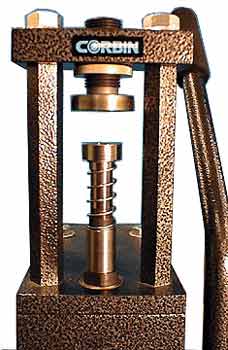
The .600 diameter cup is then lubricated and placed over the .500 first draw punch, which screws directly into the ram. The .500 draw die screws into the top of the press, and the press is set for the long stroke or reloading mode. The .600 diameter cups are drawn to .500 diameter, while the walls are made thinner and the length increases.
The special jacket drawing dies used with the JMK-1-S are not the usual JMK-1-S reducers, which are used for certain less stringent applications. They are a commercial grade JMK-2-S which uses special heat treated alloy steels, a longer punch, and a nesting-style die configuration for more precise jacket wall concentricity. The same dies can also be used, with adapters, in the -H presses made by Corbin.
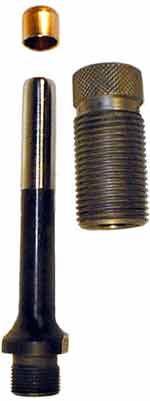
After reducing to .500, the cup is then drawn through the second draw die, to make a .452 jacket. The jacket wall will be approximately .015 inches thick, and the jacket 0.75 inches long, but in need of trimming to make the mouth even. The ET-2-S adjustable trim die is used to snip off the rough mouth section and leave an exact length, evenly trimmed jacket. Additional draws can be from .45 to any caliber down to .40, and from .40 to any caliber down to .30. Each additional draw is an optional JRD-2-S and ET-2-S pair, to reduce and then trim so that the drawn length does not exceed the punch length of the next stage.
With 5/8-inch wide x .030-thick strip, you can make .224 caliber jackets with .700 length and 0.014 thick walls, and draw from .224 to .204, .19, .17, .14, .12, or .10. The jacket maker works well with the CSP-1 press, and it is extremely efficient when used with the CSP-1H Hydro Mite press. The long, powerful stroke of the Hydraulic bench press is ideally suited to jacket making.
Please note that the diameter, length and wall thickness are the parameters which determine the volume of metal in the original disk. Any greater length, thicker walls, or larger diameter with the other parameters held the same would not be possible. In order to make larger diameter (say, .243) the length and/or wall thickness would have to be reduced. To make a longer jacket, in the same caliber, the wall thickness would need to be reduced. With a power press and larger stroke, such as the CHP-1 Hydro Press, a larger jacket making system can be used which can accept thicker and wider strip, creating more initial volume so that almost any reasonable parameters can be produced.
|



